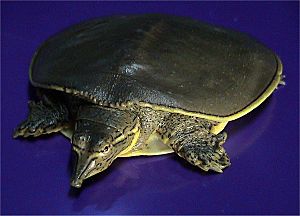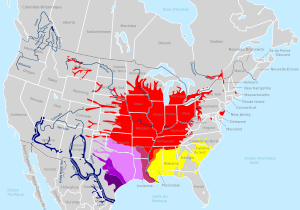Spiny softshell turtle facts for kids
Quick facts for kids Spiny softshell turtle |
|
|---|---|
 |
|
| Conservation status | |
| Scientific classification | |
| Genus: |
Apalone
|
| Species: |
spinifera
|
 |
|
| Synonyms | |
|
|
The spiny softshell turtle (Apalone spinifera) is a type of softshell turtle. It is one of the biggest freshwater turtles in North America. Its name, "spiny softshell," and its scientific name, spinifera (meaning "spine-bearing"), refer to the small, cone-shaped bumps on the front edge of its shell. These bumps are not like the scales (called scutes) found on other turtles.
Contents
About the Spiny Softshell Turtle
The scientific name of this turtle tells us a lot about it. Apalone comes from a Greek word meaning "soft" or "tender." Spinifera is from Latin, with "spina-" meaning "thorn" or "spine" and "-ifer" meaning "bearing."
This turtle belongs to a family called Trionychidae. A key feature of these turtles is their leathery, somewhat flexible upper shell, called a carapace. This is because they have lost some of the hard scales and bone tissue that other turtles have. Spiny softshell turtles also have webbed feet, each with three claws. Another special feature is their long, fleshy nose.
What Do Spiny Softshell Turtles Look Like?
The upper shell (carapace) of these turtles can be brown, yellow-brown, or olive green. The lower shell (plastron) is lighter, usually white or yellow. Young turtles often have dark spots on their carapace. As female turtles get older, their shells often become darker or splotchy. Males usually keep the same colors they had when they were young.
The exact colors can also change depending on the turtle's environment and which subspecies it is. Spiny softshell turtles have colors that help them blend in with their surroundings. This is called cryptic coloration.
These turtles also have light lines bordered by black lines. These lines run from their head down the side of their neck. The carapace can be from 18 to 54 centimeters long. Females grow larger than males. The spines that give them their name are found along the front edge of the carapace. Males tend to have more of these spines. The differences in color, size, and spine presence between males and females show that this species has sexual dimorphism. This means males and females look different.
How Spiny Softshell Turtles Breathe
A. spinifera turtles can breathe in two ways. They can breathe air, like us, or they can exchange oxygen and carbon dioxide while underwater. Several things help them breathe underwater. They have more skin surface area and blood flow. Their lungs are smaller, and they have more special breathing tissue in their cloaca (a body opening) and throat.
Spiny softshell turtles rely more on underwater breathing than other freshwater turtles. Because of this, they cannot handle water with very low oxygen levels. This is especially important when they hibernate in winter. They must choose safe spots where the water is unlikely to run out of oxygen.
Where Spiny Softshell Turtles Live
The spiny softshell turtle lives in many places. Its range covers much of the United States. It also extends north into the Canadian provinces of Ontario and Quebec. South of the U.S., it can be found in the Mexican states of Tamaulipas, Nuevo León, Coahuila, and Chihuahua.
Their Habitat and Environment
Spiny softshell turtles live in many kinds of freshwater bodies. These include ponds, lakes, rivers, and streams. They prefer shallow water, usually less than 1 meter deep. However, they can also be found in water as deep as 10 meters. They can live in areas with different amounts of plants. While they usually prefer slow-moving water, they can handle faster currents better than some other turtle species.
These turtles like waters with sandy bottoms and clean, sandy banks. Sandy places are important for them. They use them for nesting, for young turtles to grow properly, and for camouflage. Spiny softshells move between different areas depending on the warm and cold seasons. During warm months, they move around more within their chosen area.
What Spiny Softshell Turtles Eat
Spiny softshell turtles eat many different things. They often eat insects, crayfish, fish, and mussels. They also eat some plant material like algae. They usually feed on the bottom of the water. They can actively hunt for food, or they can bury themselves in the sand and wait to ambush prey.
Spiny Softshell Turtle Life Cycle and Reproduction
Spiny softshell turtles start mating when they are between 8 and 10 years old. A large female turtle can live for up to 50 years! They mate in deep water during the middle to late spring. The male turtle will gently nudge the female's head while swimming. If she agrees to mate, the male will swim above her without holding her with his claws. This is different from how some other turtles mate.
A few months later, the female turtle lays her eggs. She usually chooses a sunny sandbar or gravel bank near the water. She digs a flask-shaped hole for her nest. A female turtle can lay eggs more than once in a single season. She lays between 9 and 38 round eggs, which have hard, calcium-rich shells. The eggs are laid around July and September. They hatch in the spring.
Unlike some other turtles, the sex of spiny softshell hatchlings is not decided by temperature. It is determined by their genetics. The nesting sites are at risk from predators like coyotes, foxes, and raccoons.
Types of Spiny Softshell Turtles (Subspecies)
There are six recognized types, or subspecies, of A. spinifera. These include the main subspecies:
- Northern spiny softshell turtle (or eastern spiny softshell), A. s. spinifera (Lesueur, 1827)
- Gulf Coast spiny softshell turtle, A. s. aspera (Agassiz, 1857)
- Black spiny softshell turtle or Cuatro Cienegas softshell turtle, A. s. atra (Webb & Legler, 1960)
- Texas spiny softshell turtle, A. s. emoryi (Agassiz, 1857)
- Guadalupe spiny softshell turtle, A. s. guadalupensis (Webb, 1962)
- Pallid spiny softshell turtle, A. s. pallida (Webb, 1962)
One subspecies, Apalone spinifera hartwegi, was once recognized. However, since 2011, it is now considered the same as A. s. spinifera.
Images for kids
-
Pallid spiny softshell (Apalone spinifera pallida) in Colorado County, Texas (June 28, 2014)
See also
 In Spanish: Tortuga de caparazón blando espinosa para niños
In Spanish: Tortuga de caparazón blando espinosa para niños





